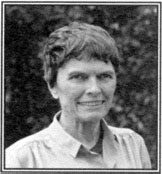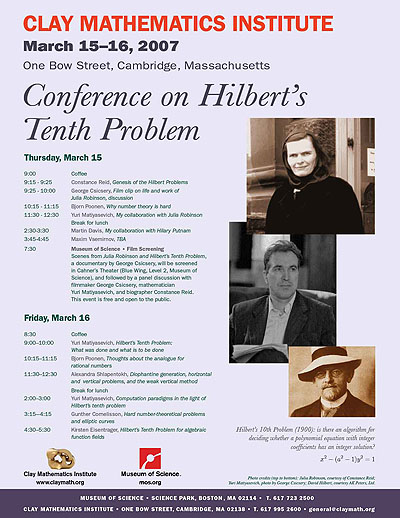Julia Robinson
by Andrew Boyd
Today, we did it! The University of Houston's College of Engineering presents this series about the machines that make our civilization run, and the people whose ingenuity created them.
Ambition isn't a bad word. It's the drive to make things happen. But when different people's ambitions collide, the result's usually not pretty.

The story of Julia Robinson, however, is different. In 1948, just as she was finishing her Ph.D. at Berkeley, Robinson began work on one of the most celebrated unsolved mathematical problems of the twentieth century. It was known as Hilbert's Tenth. Distinguished mathematician David Hilbert posed twenty-three "grand challenge" problems at a meeting in Paris in 1900. They're very famous. The tenth asked about a step by step process. Today, we'd call that process an algorithm. But questions about algorithms were brand new at the time.
Robinson found herself drawn to Hilbert's Tenth as a graduate student. It was a problem she'd work on for the rest of her life. And she made tremendous progress. She proved important results. One was called the JR – as in "Julia Robinson" – hypothesis. Her results didn't solve Hilbert's Tenth, but they opened doors. They reduced the complicated problem to problems that looked a lot easier. Still, she couldn't solve them.
Many other researchers worked on Hilbert's Tenth besides Robinson. It was more than just a math problem. It was a chance to carve a place in history. It was the type of problem that attracted ambitious people. But the problem was hard. Would it be solved? If so, who would solve it? Finally, in 1970, word came that a young, unknown Russian named Yuri Matijasevich had laid the problem to rest. He built his proof on the foundation provided by the other researchers— Robinson in particular.
The story could end here. Matijasevich solved the problem. Matijasevich gets the credit. But that's not what happened. The many researchers —Robinson included— patted each other on the back and said, "Good job, we did it." Now, this isn't to say there were never any competitive moments. Collaboration and competition are both catalysts for discovery. But history's left us a remarkably convivial picture – a picture free of wanton claims that "I did it." And it's a picture where Julia Robinson stands front and center — though not alone.
We can see the importance of her work through the many honors she received. In 1975 she was the first woman mathematician elected to the prestigious National Academy of Sciences. She became the first woman president of the American Mathematical Society in 1982.
Robinson broke barriers as a woman. And she was well aware of it. But she was first and foremost someone who simply loved what she did. "All this attention," she once wrote, "has been very gratifying but also embarrassing...Rather than being remembered as the first woman this or that, I would prefer to be remembered as a mathematician should, simply for the theorems I have proved and the problems I have solved."
I'm Andy Boyd at the University of Houston, where we're interested in the way inventive minds work.

A conference agenda for a meeting on Hilbert's tenth problem showing, from top to bottom, Julia Robinson, Yuri Matijasevich, and David Hilbert.
Notes:
Martin Davis and Hilary Putnam are two mathematicians whose names are closely tied to the solution of Hilbert's Tenth but are not included in the text.
Click here for a list of all of Hilbert's problems and their status. Accessed May 25, 2008.
The quote by Julia Robinson is taken from page 271 of William Dunham, The Mathematical Universe. (New York: Wiley & Sons, 1994).
References:
M. P. Cooney, ed. Celebrating Women in Mathematics and Science. (Reston, Virginia: The National Council of Teachers of Mathematics, 1996).
M. Davis and R. Hersh, "Hilbert's 10th problem." Scientific American, November 1973, 84-91. A highly accessible account of Hilbert's Tenth for non-mathematicians.
L. S. Grinstein and P. J. Campbell, eds. Women of Mathematics: A Bibliographic Sourcebook. (Westport Connecticut: Greenwood Press, 1987).
Y. Matijasevich (with a foreward by M. Davis and H. Putnam). Hilbert's Tenth Problem. (Cambridge, Massachusetts: The MIT Press, 1993). An excellent book for students of mathematics and those interested in a detailed history of the solution of Hilbert's Tenth.
Y. Matijasevich, “My collaboration with Julia Robinson.” The Mathematical Intelligencer. 14(4), 1992, 38-45.
To the best of our knowledge, Julia Robinson's widely-reproduced photo (above) is in the public domain.